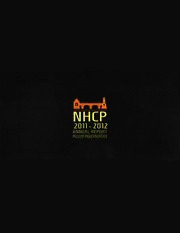
Annual Report 2011-2012 PDF
Preview Annual Report 2011-2012
NHCP Annual Report 2011 - 2012 Editor Dr. Maria Serena I. Diokno Production team Veronica A. Dado Carminda R. Arevalo Paulita C. Avestruz Designer Miguel Leonardo F. Camacho Copyright ©2013 by National Historical Commission of the Philippines All rights reserved. No part of this book may be reprinted without written consent. ISSN 2345-8003 Table of Contents A Word from the Chair Maria Serena I. Diokno About NHCP The Board History of the Commission Our Mandate Five-Year Plan 2011-2016 Accomplishments 2011-2012 Museum Modernization Program Commemoration and Recognition Program Restoration and Conservation Program Research and Dissemination Program Training and Networking Program Organizational Capacity Enhancement Program Budget NHCP Shrines and Landmarks A Word from the Chair It is the mission of the National Historical Commission of the Philippines to bring Philippine history closer to the people, of whatever age, gender or faith, wherever in the country and even to Filipinos abroad. I realize this is a challenging task not because of the magnitude of the constituency we serve, but more simply because history does not appeal except to the special individuals who personally enjoy it. I am aware their number is not as large as we historians would like. I am also aware that history does not pay, and students looking to land a decent-paying job after college generally do not have history in mind. History could also be better taught; I have found that students who appreciate history had the benefit of good history teachers. Yet our history is fascinating, and much of it still is to be learned. Parts of the country, for example, notably Mindanao and the Visayas, have long been neglected in Philippine history. There are moments in our past we can be proud of and others we might prefer to forget, but all of them tell our story as a people, carving out our identity and struggling to stand on our own: free, proud and equal, and respectful of each other’s rights. “I fight for the nation, the Philippines,” Jose P. Rizal declared in his letter to fellow propagandist Marcelo H. del Pilar in 1891. And Rizal’s story did not end with him. On 19 June 2011, the Commission opened the yearlong commemoration of the 150th birth anniversary of Rizal through activities in partnership with citizens and groups, schools and various institutions, government units and embassies. On 30 November 2012 we kicked off preparations for Andres Bonifacio’s sesquicentennial birth anniversary in 2013. And in 2014 we will celebrate the 150th birth anniversary of yet another hero, Apolinario Mabini. What a wonderful time to be at the Commission! In this report I explain our five-year plan and parts of it that the Commission accomplished in 2011 and 2012. We look forward to an exciting future and thank all those who have worked with and supported us. ABOUT NHCP The Board Left to right: Mr. Jeremy Barns, Director, National Museum of the Philippines (ex-officio); Dr. Ferdinand C. Llanes, History Department, University of the Philippines Diliman; Dr. Rene R. Escalante, History Department, De La Salle University; Mr. Victorino M. Manalo, Executive Director, National Archives of the Philippines (ex-officio); Dr. Maria Serena I. Diokno, History Department, University of the Philippines Diliman, NHCP Chair; Ms. Fe Buenaventura-Mangahas; Mr. Ludovico D. Badoy, NHCP Executive Director (ex-officio); Dr. Abraham P. Sakili, Department of Art Studies, University of the Philippines Diliman; Atty. Antonio M. Santos, Director, National Library of the Philippines (ex-officio). History of the Commission Our Mandate As the primary government agency responsible for the promotion of Philippine history, the functions of the NHCP are to: Commemorate significant historical events and declare historically significant sites, structures, events and figures; Conduct research, produce materials in various media, and publish and disseminate historical works; Undertake and prescribe the manner of restoration, conservation and protection of the country’s historical movable and immovable objects; Manage, maintain and administer national shrines, monuments, historical sites, edifices and landmarks of significant historic-cultural value; Regulate the design and manufacture of heraldic items of government agencies, pursuant to RA 8491 (Flag and Heraldic Code of the Philippines); and Resolve historical controversies or issues.
